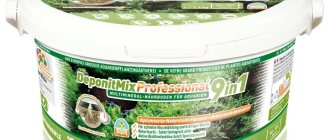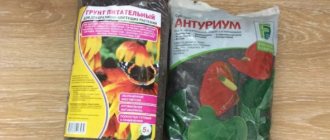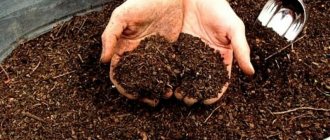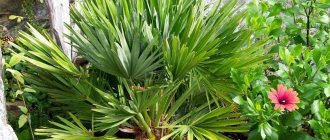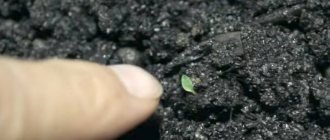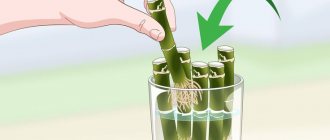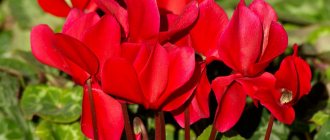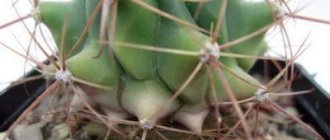General characteristics of soil for palm trees
If we talk about the characteristic features of the soil mixture, then when choosing a substrate it is worth paying attention to a number of aspects that are considered key:
- The soil should allow air to pass through and be loose.
- Acidity should be low, within 6.5.
What kind of soil and pot do you need for a palm tree?
Even a young palm tree needs nitrogen, but as a rule, substrates sold in flower shops contain this element in sufficient quantities. If necessary, you can feed the palm tree to speed up its growth. But the main thing here is not to overdo it.
The palm tree, as a plant that prefers warmth and sun, does not tolerate stagnant moisture; for this reason, it is better for the gardener to take care of the drainage system in advance.
If the soil is loose, allows moisture and air to pass through well, is low in acidity, and contains the necessary nutrients, then it can be safely used for planting.
Growth form
Despite the generally accepted idea of palm trees as single-trunked, non-branched trees, there are a huge number of palm trees in the world that form not one trunk, but several or many, with a bush-like growth form. Such multi-stemmed palms are especially characteristic of the lower layers and understory of tropical rainforests. Moreover, in some shoots develop from axillary buds at the base of the stem, and then a compact bunch of stems is formed, as in the Madagascan palm tree Chrysalidocarpus yellowish and the Brazilian “cabbage palm.” In others, such as the Chinese raisa palm, they form on underground stolons or rhizomes, forming more or less loose thickets. Among multi-stemmed palm trees, the predominant ones are low-growing ones, with relatively thin, often bamboo-like trunks, or very miniature plants with reed-like stems. These are the numerous species of the American mountain palm, Hamedorea, whose height on average is 2-2.5 meters. And some types of Reinhardtia raise their thin (pencil-thick) stems only half a meter. Among the palm trees there are even “stemless” plants. their greatly shortened stem is not visible, it is located underground, and only a rosette of leaves rises above the soil surface, like the American palmetto palm, growing in the dry pine forests of Florida.
If the formation of lateral shoots at the base of the stems is a common occurrence among palm trees, then the branching of the trunk and the formation of a branched crown is characteristic of only a few species, which is why the silhouette of the Theban hyphaena, or doom palm, seems so strange, the trunk of which repeatedly branches dichotomously (forked), bearing on at the end of each branch is a bunch of fan leaves.
In general, among palm trees you can find trunks of the most unusual shapes. The short trunk of Giophorba bottlenose, endemic to the Mascarene Islands, is perceived as a funny curiosity, resembling a pot-bellied bottle with a sharply narrowed neck. A similar, only more elongated silhouette has the Cuban palm Gaussia superb, a narrow endemic of the Pinar del Rio province, settling in rock cracks along the ridges of limestone outcrops - mogots. The unusualness of its appearance is complemented by hanging long rope-like roots extending from the turnip-like swollen base of the trunk. A bizarre landscape is formed in the swampy sandy savannas of Western Cuba by the “barrigona” palm, short, with an excessively swollen trunk in the middle on a thin “leg” and with a thin “neck” bearing a tiny crown. From its barrel-shaped trunks, island residents make stupas for grinding grain, containers for storing food, and canoes.
The trunk of the Cuban gastrococos palm tree, planted with long black needles, looks like a giant prickly spindle. The Cuban palm Copernicia grandifolidae looks like a real monster. The whole thing, from the ground to the top of the crown, looks like a huge “disheveled” barrel due to the mass of dead, bent down leaves, covering its trunk like a huge fur coat. This dense mass of dry leaves, called the “skirt,” provides shelter for hundreds of bats that hide from the bright daylight here.
Many palm trees that live in wetlands, gallery forests along flooded river banks, as well as in mountain forests of the fog belt have a very unusual appearance. Their trunks rise above the ground on “stilts” - stilted roots extending from its lower part. They, like heavy anchors, sink into unsteady muddy or loose rocky soil, giving the tree amazing stability. Many of them have stilted roots equipped with prickly thorns - modified lateral roots that protect the tree from being eaten by animals.
There are palm trees with a creeping trunk. This is the American oil palm, the corozo, a palm tree that “walks.” As the trunk grows, its old part lies down, becoming covered on the underside with a brush of adventitious roots, and eventually dies off, while the young, ascending end of the trunk raises a crown of long feathery leaves above the ground, thus growing at one end and dying off in another, the palm tree moves imperceptibly, moving away from its original location.
Finally, a fairly large group among palm trees is made up of climbing liana palms. Their thin, flexible, often prickly, very long stems extend 100 meters or more (in some species of rattan palm, even 300 meters). They climb high into the crowns of trees, carrying feathery leaves and inflorescences into the upper canopy of the forest. Some of them cling to the support with long whip-like prickly tendrils - continuations of leaf stems, the feathers of which have changed into sharp spines bent downwards, others - with whip-like sterile inflorescences, seated with claw-like spines. Often, not finding support, the stems fall down, lie on the ground and rise again, bending like a snake, entangling trees and shrubs with giant thorny festoons and forming an insurmountable barrier for humans and animals.
Composition of soil for plants
If you buy a ready-made substrate, then study the packaging; all the components of the mixture are indicated there; this information will be useful, as it will help you decide on your choice. Classic soil intended for planting palm trees should consist of the following components:
- high and low peat;
- coarse or river sand;
- mineral fertilizers;
- vermicompost;
- expanded clay drainage;
- dolomite flour.
Peat is turf soil that can be added gradually as plants grow and develop. And low-lying peat and leaf soil contain the remains of the root system of small plants.
By adding sand to the soil, you will be able to increase its useful characteristics - the mixture will easily allow air and water to pass through.
Agroperlite is also added to the soil composition. These are white granules that help improve breathability. Agroperlite increases air permeability, but adding sand helps to avoid caking and improve the quality characteristics of the earthen mixture.
Manufacturers can supplement the composition with a component such as hydrogel; its presence should not be confusing. Like vermiculite, hydrogel improves soil permeability and retains moisture.
Frequently asked questions and common mistakes
Unfortunately, many people make serious mistakes. Because of this, the plant not only begins to get sick, but also dies. Why is this happening?
- The transplant was carried out during the dormant period from autumn to winter.
- During the cleaning of the roots, individual parts were deformed.
- The ground was heavily flooded with water.
- Lack of light.
- In summer, no drug was used to stimulate root growth.
Why does the plant dry out?
- If the plant dries out after replanting, the soil you selected is probably not suitable for it.
- Another reason is damage to the roots, as a result of which the plant cannot fully feed.
- Lack of nutrients in the soil is also a reason for drying out. Therefore, try using a special fertilizer for palm trees.
Take care of your plants, as they create coziness and a pleasant atmosphere in your home. And just as in the case of pets, we are responsible for those we have tamed.
Additional soil components
The minerals contained in the soil help the plant to develop according to its natural programs.
As a supplement, there are mineral components that are part of the soil; they help optimize the plant growth process.
For example, vermicompost is another component of healthy soil. In nature, it is the food of earthworms, which enrich the soil and saturate it with oxygen.
The presence of drainage expanded clay in the composition will help to avoid excessive humidity, which is detrimental to palm trees.
To make the plant quickly grow, you can add leaf humus; it is often mixed with soil.
Rotten birch leaves will help saturate the soil with useful substances.
What a date palm looks like and how it blooms: photo and description of the tree at flowering time
Palm flower stalks emerge from the axils of the leaves. They visually resemble an open saber and are combined into paniculate-type inflorescences. Each flower consists of 3 petals. They are small in size. The flowering feature of the date palm tree is dioecy. There are both male and female flowers on the same plant. Moreover, the first ones are much smaller, but are collected in denser and straighter inflorescences. Their color is creamy. Each has 6 stamens. The second ones are painted yellow. They are distinguished by luxurious splendor, look stronger, and sag due to the weight of the fruit that originates in them.
How the date palm blooms, look at the photos below:
Soil for young palm trees
Depending on the age, palm trees have certain needs; to satisfy them, it is worth paying attention to the composition of the soil mixture.
The following universal soil is suitable for young palm trees:
- Wood and leaf soil are mixed in equal parts, maintaining a 1:1 ratio.
- High-moor peat and coarse sand are added to the resulting mixture.
- The entire soil can be divided into 3.5 parts: 2 of which are leaf and turf soil, 1 part is high-moor peat, and half or ½ is sand.
As needed, and this is usually twice a year, the plant is fed with fertilizers: during planting, before or a few days after. To enrich the soil during the active growth phase, which occurs in the spring-summer period.
Every year, the young plant is transplanted into a new container, choosing the pot that is needed for the palm tree and at the same time completely replacing the soil. This is ideal. But often there is no time for a transplant. In this case, it is worth completely replacing the top layer of soil. But be careful, because most palm trees have a weak root system; minor damage can lead to the death of the seedling.
Palm trees respond well to foliar fertilizers that are sprayed on the leaves; you can use them as an alternative. But they cannot fully replace soil products.
Features of care after the procedure
The transplanted tropical beauty should be placed in partial shade; direct sunlight should not be allowed to hit its leaf mass. Otherwise, there is a risk of burns on the sheet plates. It is advisable to maintain the temperature in the room within +18-23 ° C. Irrigation measures are carried out when the top layer of soil dries out. It is not advisable to spray for the first time after transplantation. Feeding procedures are also not carried out during the first two months after replacing the container and soil.
Growing palm trees at home with the right approach is quite a promising activity. The main thing is to adhere to the rules of agricultural technology and correctly transplant into a new pot. A signal about the need for such a procedure will be the roots of the flower peeking out of the drainage holes.
Land for mature palm trees (over 5 years old)
Older plants require specific soil that meets all their needs. The composition of soil for an adult palm tree includes the following components:
- mix clay-turf soil and deciduous soil in equal parts;
- add high-moor peat and rotted manure to the mixture;
- Sand and charcoal will help supplement the composition.
An adult palm tree needs to be replanted every 5 years.
A drainage layer of several centimeters is placed at the bottom of the pot. It could be expanded clay. The drainage can be from 3 to 6 cm thick, depending on the size of the pot.
An adult plant is replanted every 5 years, the top layer of soil is replaced every 3 years.
How to transplant?
Since representatives of the Palm family do not tolerate injury to the roots, it is better to replace replanting with a complete replacement of the soil with gentle transshipment, when the integrity of the earthen coma is preserved.
You need to replant a palm tree in several stages:
- Carefully remove the plant from the old pot, shake the soil a little and inspect the roots, removing any suspicious, rotten or dead shoots. You need to use a sharp, disinfected knife or scalpel.
- Sprinkle the cut areas with crushed charcoal or activated carbon to disinfect and prevent future rotting.
- Place a drainage layer (3-4 cm) in another pot using expanded clay, small crushed stone, ceramic shards or charcoal, sprinkle with soil on top.
- Place the palm tree in the center of the flowerpot, if necessary, straighten the roots that have escaped from the earthen clod without damaging them.
- Fill the voids with fresh substrate, compacting it slightly. Water the palm tree and add soil after shrinking. Make sure that the root collar is not buried.
For successful acclimatization after transplantation, the palm tree should be in light partial shade for 2-3 days, then the pot can be moved to a windowsill under diffused light.
Exposure to drafts and cold will cause irreparable harm to a fragile plant, so opening a window or balcony door is not recommended. The optimal temperature regime is +20-+25 degrees Celsius.
Watering is only allowed in moderation - severe waterlogging of the soil will cause rotting of the roots, which cannot cope with large amounts of water.
The palm tree will withstand a change of environment much easier if it is sprayed regularly.
You should not apply fertilizer immediately after transplantation - it is better to wait for the first signs of growth and successful rooting. The palm tree will take root in the new pot in about 2 weeks.
As you know, palm trees love well-lit areas and moist soil, so many of the cultivated species of this plant are not suitable for growing at home.
However, there are several varieties of the plant that take root well at home.
To properly grow a home palm tree, it is recommended to choose the right soil for the plant, a flowerpot and know how to replant the planting.
Choosing ready-made soil for palm trees
Let's consider several options for ready-made mixtures and study their characteristics:
| Garden of Wonders | The composition includes large river sand, mineral components, as well as high-moor peat. |
| Albin | The soil is incredibly popular among gardeners and meets all the necessary characteristics. |
| Flower happiness | The composition contains complex fertilizers, dolomite flour, peat soil and sand. |
It is believed that the soil sold in the store is not suitable for planting plants that are more than three years old. Then a small amount of substrate is added to the soil, the remaining components are formed independently.
Store-bought soil is ideal for planting seedlings.
Preparatory work
Replanting a palm tree begins with preparing high-quality soil and choosing a new pot.
Optimal soil composition
The main requirements for a high-quality substrate for planting palm trees are looseness, air and water permeability, and the presence of nutrients.
Attention should be paid to acidity, the level of which should be in the range of 6.3-6.5 pH.
Using exclusively purchased substrate for replanting is advisable for young seedlings that need light soil.
In other cases, it is better to use a store-bought mixture as a base, additionally adding sand, leaf soil, turf soil and peat to it.
However, it is best to prepare the soil mixture yourself, selecting components according to one of the following schemes:
- 1 part sand and humus, 2 parts garden soil;
- 2 parts each of turf and leaf soil, 1 part each of peat, coarse sand and rotted manure, crushed charcoal;
- Leaf humus, clay turf, peat, sand, crushed charcoal and organic fertilizer in equal proportions;
- Lowland peat, coarse sand, dolomite flour and mineral fertilizer in equal proportions.
Before use, the soil mixture must be disinfected in one of the following ways:
- Heating in the oven at a temperature of about 100 degrees;
- Steam for half an hour over a boiling water bath;
- Spill with a weak solution of potassium permanganate.
The palm tree can be transplanted into a sterilized substrate only after it has completely cooled.
Which pot should I transplant it into?
Aesthetic appeal is not the most important point that you should focus on when choosing a flowerpot for a palm tree. The container must be stable and high so that the plant does not fall from the windowsill or stand.
It is better to give preference to pots of light colors - they do not attract sunlight, thereby preventing overheating of the roots.
It is worth paying attention to the following points:
- With each subsequent transplant, the size of the pot is increased by 2-3 cm so that the root system can develop normally.
- For massive palm trees, flowerpots are selected whose diameter is 1/3 larger than the previous container.
- The presence of several drainage holes at the bottom is mandatory.
You should not take pots “for growth”, since a large amount of free space will slow down the growth of the palm tree.
The root system will develop the soil to the detriment of the growth of green mass, and the risk of flooding the palm tree increases significantly.
